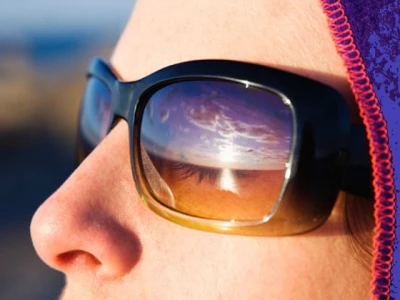Why UV shades are good for you
Dangers of too much sunshine
We all love to get out in the sunshine and make the most of the clear blue skies, fresh air and warm weather.
There are many benefits of bathing in natural sunlight. It is, for example, known to improve mood, making people feel better and giving them more energy.
And we all know that vitamin D from natural sunlight helps us build healthy bones and good teeth.
We often count the days before we can turn our skin from pasty white to a golden summer tan. However, excessive sun exposure is an area where too much too quickly is not only inadvisable but can even be dangerous.
It pays to be smart when heading for the outdoor sunbed, especially in a holiday hotel overseas where sunshine and temperatures may be much more than we are used to.
Sunbathing is not without risk
While medics are very much in favour of daily doses of fresh air and sunshine, soaking up large quantities of strong sunlight over short periods is not without risk, especially if you are not used to it. It can take less than 15 minutes for your skin to absorb enough sunlight to promote sunburn, although the effects may not be apparent until several hours later. The damage caused to the human body through sunburn and heat rash is well known. The skin can become very sore and red and start to blister and peel after a few days. What is less well known is the damage caused to your eyes through excessive exposure to bright sunlight. People should consider the extra eye protection they need, especially on holiday.
Not all light is good for you
Sunlight is the most common source of high-energy ultraviolet (UV) rays. Ultraviolet (UV) comes from the Latin word 'ultra', which means 'beyond violet', the highest frequency of visible light. Fortunately for us, most of the dangerously high UV (beyond violet) is screened out by the ozone layer in the Earth's atmosphere. The UV light that does get through our atmosphere is mostly Ultraviolet A (UVA) and Ultraviolet B (UVB), both at the lower end of a spectrum that runs from UVA through FUV (Far Ultraviolet) to EUV (Extreme Ultraviolet). Scientists have known for some time that exposure to sunlight at the boundary between UVA and UVB light is responsible for skin damage such as sunburn. It may even be a significant factor in some skin cancers. Studies also show that exposure to light levels at UVB and above can affect the human eye. UVB in sunlight can cause photokeratitis, more commonly called 'snow-blindness', and it can damage vital parts of the eye in the cornea, lens, and retina.
Eyes prone to sunlight damage
All of us are at risk of harm from the sun throughout the year, but the greatest danger is on holidays when we tend to spend much more time outdoors than usual. The reflective qualities of sand, snow, and water can amplify the effects of UVB radiation and harm unprotected eyes. Those who spend much time on the beach or skiers who go out on the snow slopes are particularly prone to damage. Medics warn that eye damage from exposure to UVB light may occur gradually over time and, once done, may not be reversible. Some people are also more sensitive to UV light than others. So, when choosing sunglasses, favouring brands that give the best protection against UVB light is essential. Although UVB may be largely absent from sunlight, it is still worth considering when purchasing sunglasses, especially in beach and ski-slope conditions where your eyes are likely to be bombarded with bright light for long periods. Protective sunglasses are beneficial to anyone exposed to higher levels of UVB light. Excessive exposure to the UV from sunlight or tanning salons can harm the cornea, the refracting surface of the eye that focuses light and images to the retina. Good UV-protective lenses are a must for anyone who uses a tanning salon. Skiers, snowboarders, or mountaineers must also take care as UV is more intense at high altitudes. The snow reflection can double the exposure to light.
Check the UV label
You can't tell how much UV protection you can get from a pair of sunglasses simply by looking at them. Neither the price nor the lens colour gives any indication. Most people in the market for UV sunglasses will have to rely on the label to explain how much protection they offer. There are industry standards, but it is worrying that not all manufacturers adhere to them. Many modern sunglasses have a sticker or label claiming 100% UV protection, but they won't protect eyes from the reflected light that arrives around the lens. It is a good idea to wear a wide-brimmed hat as well as sunglasses. The hat will block about half of the UV rays and limit the rays that hit the eyes from above or around the sunglasses. Sunglasses with acrylic plastic lenses will give slightly higher protection than glass, which is transparent to UVA, unlike the conventional acrylic plastic used for lenses. Some plastic lenses, such as polycarbonate, block most UV rays, and many modern sunglasses have a protective coating that will block UV light completely. People who work or play in the sun for long periods will be at the most significant risk, with sun-related eye problems increasing for those who have had cataract surgery or take certain medicines that increase the eye's sensitivity to light. It's important to have a complete ophthalmic examination at least once a year to ensure your eyes stay good and healthy.
Read more about sunglasses
Choosing the best sunglasses
Glasses designed to fit your face
Sunglasses for the ski slopes


